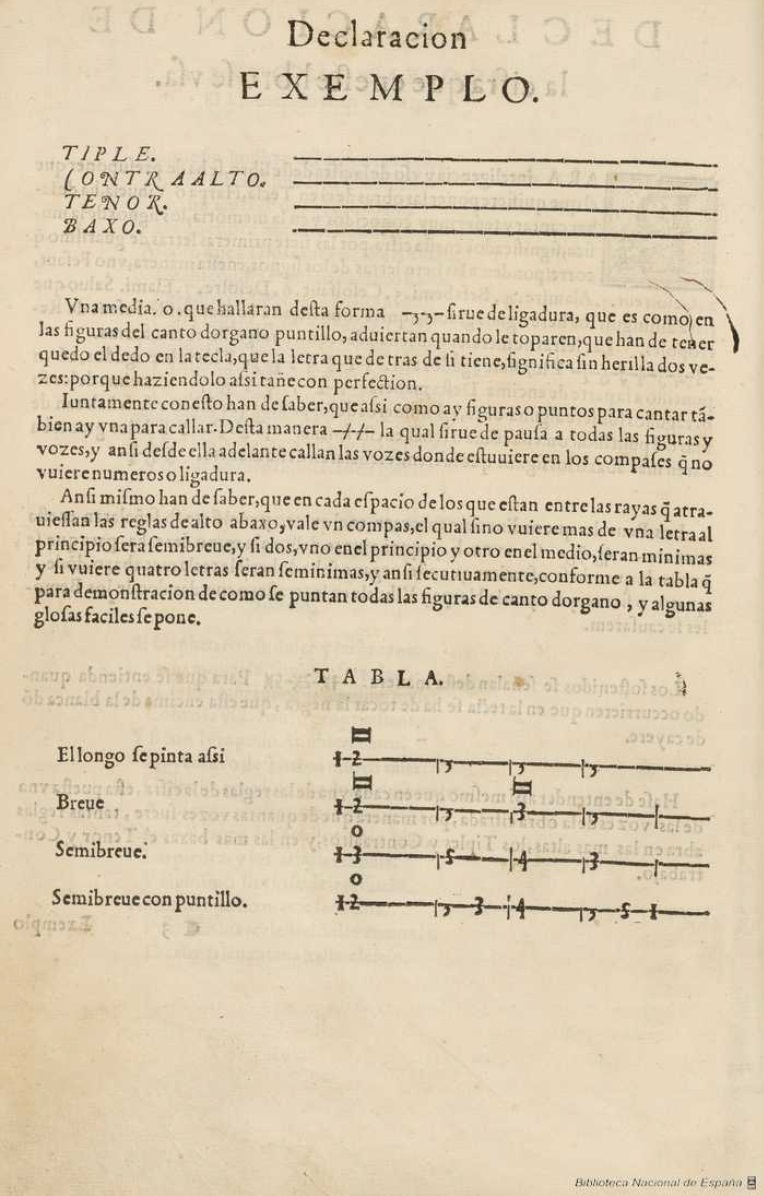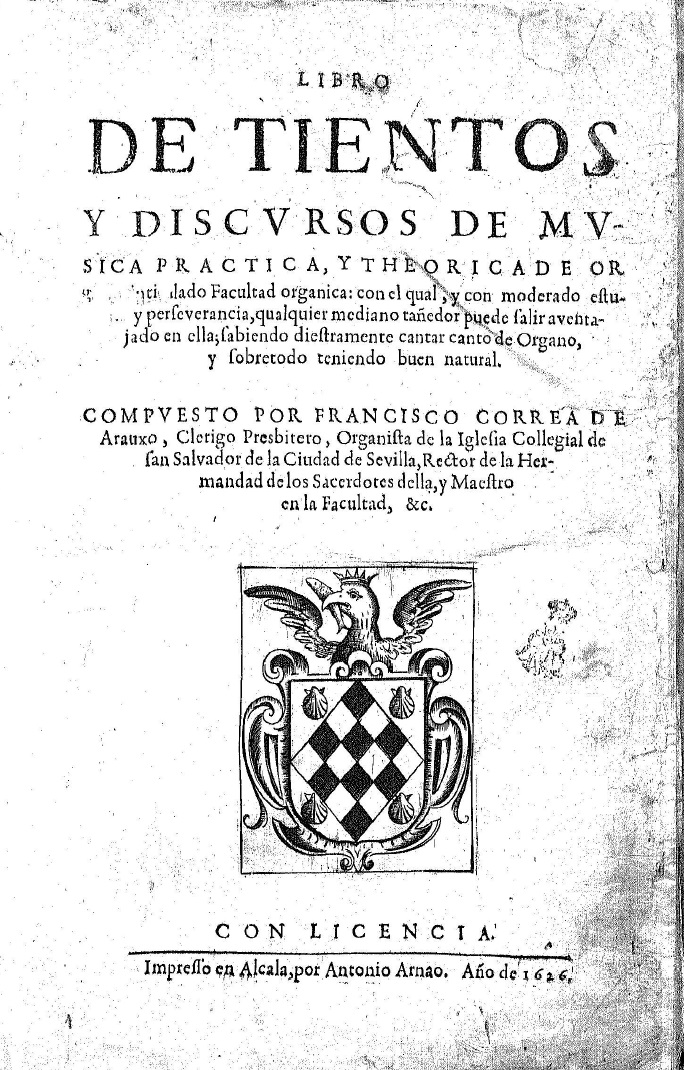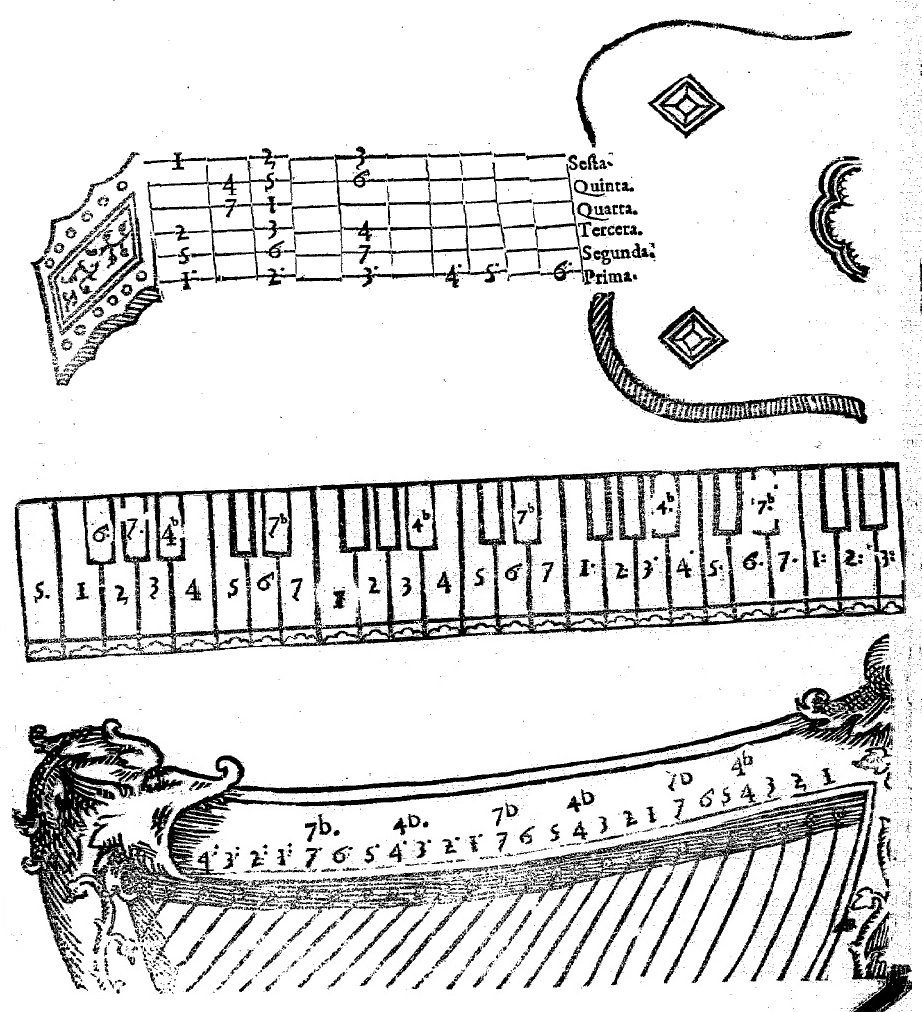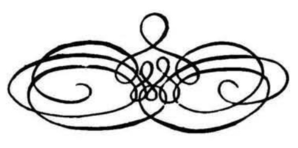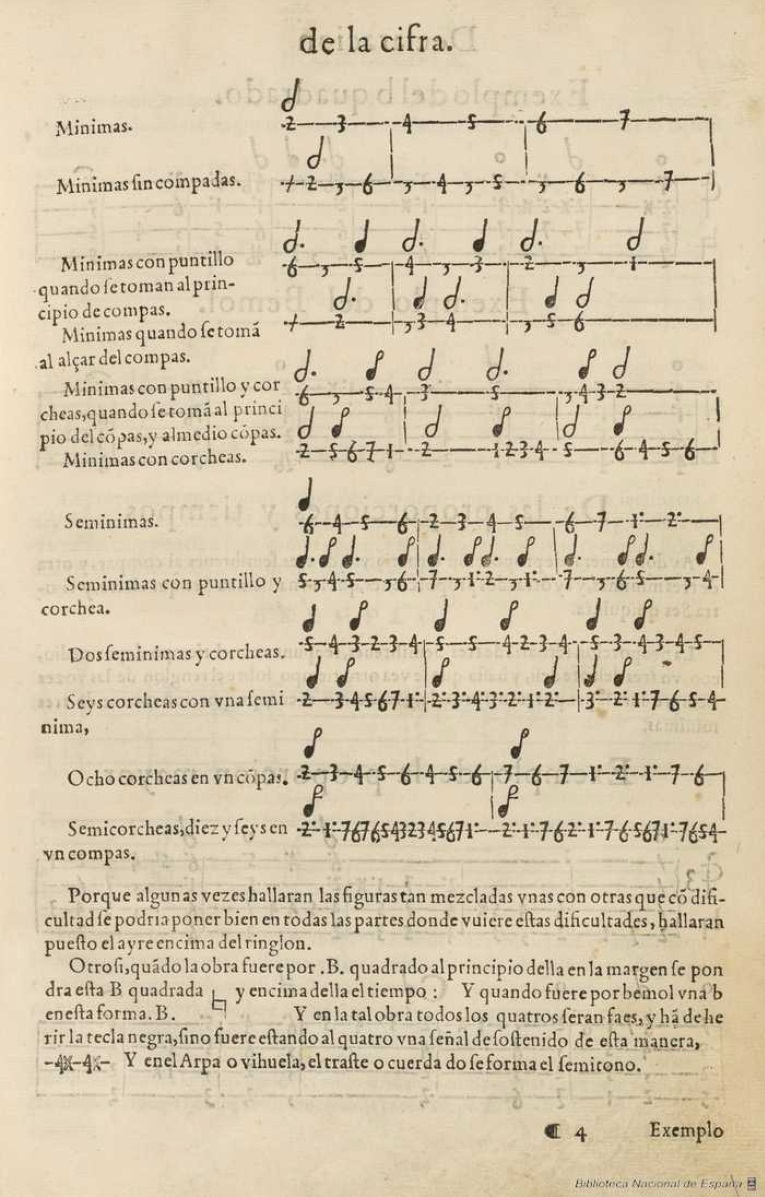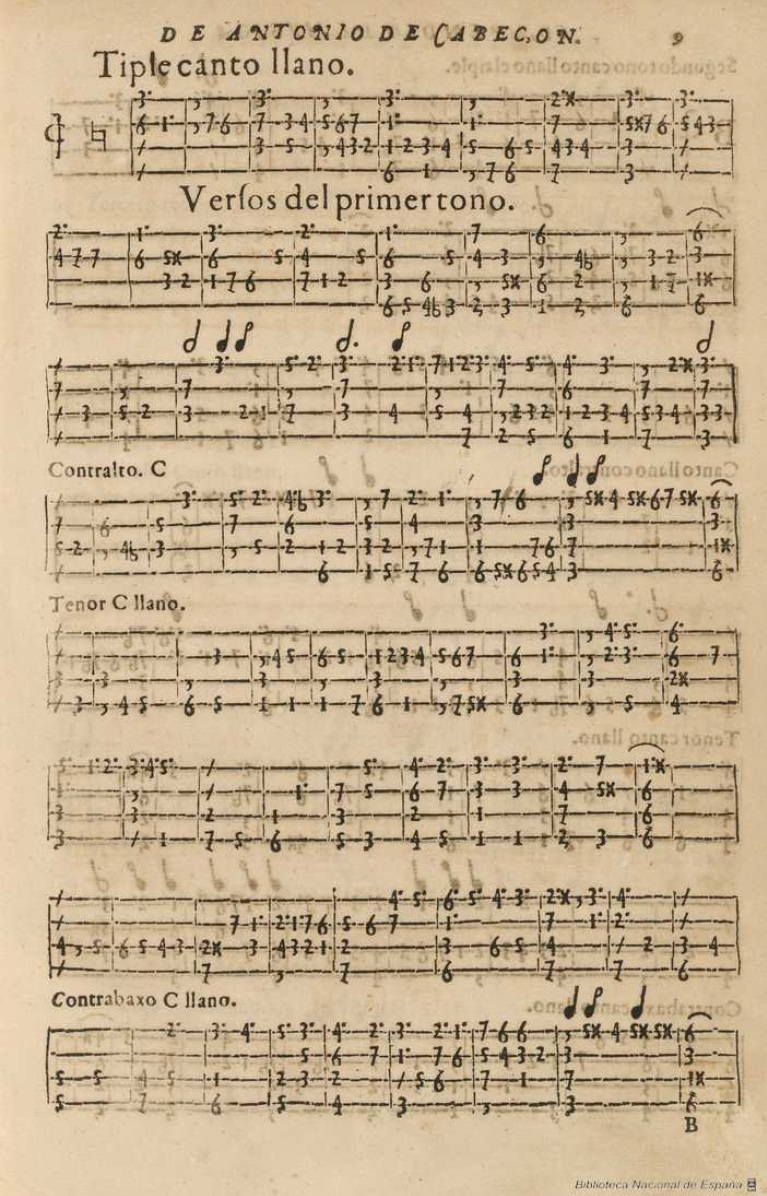Chapter 3
The Spanish Tablature
The invention of Spanish keyboard tablature is largely a product of vihuela music and its notation. Williams attributes the arrival of keyboard tablature to the introduction of lute tablature by Luys de Narváez (1490-1547) in 1538 in Spain for the Spanish guitar, vihuela.1 Lash also traces the origins of Spanish keyboard tablature to the earlier lute tablatures in Spain, as an adopted form from the vihuela tablature which developed in the early 16th century. The vihuela used a type of pseudo-staff, one line for each course and numbers to indicate the frets. This system translated as one line for each contrapuntal voice and numbers to indicate the pitch (instead of letters) on the keyboard.2
An epigram to Antonio de Cabezón by Alonso de Morales from Obras de musica (1578)
Francisco Corrêa de Araujo (1575-1655) and Facultad organica (1626)
Nearly 50 years after the publication of Obras comes the last Spanish keyboard source to be printed in tablature. With the earliest keyboard source from the Iberian Peninsula from 1540, a century of Iberian keyboard literature has been notated in the number system. 3 There is a mention of the Cabezóns4 in Corrêa’s preface to Libro de tientos y discursos de musica practica, y theoríca de organo, intitulado Facultad organica.5 In addition the treatise of Tomás de Santa María (ca.1510-1570) Arte de tañer fantasia (Valladolid, 1565), Facultad organica is an exhaustive source of Spanish keyboard performance practice. The 26-leaf preface has very detailed instructions on ornamentation, fingering, playing techniques, tablature notation, inequality in rhythm of faster and smaller value notes, to name a few. Lash, in a preface to his translation of Corrêa’s Facultad organica, characterizes his music as an “evolution from refined high Renaissance to early Baroque."6 A modern transcription in complete edition of Facultad organica has been produced by Macario Santiago Kastner in the1940s.7 The written contests of Facultad will be discussed in more detail in “Chapter 9: Tablature and Historically Informed Performance Practice.”
Lash lists the very first appearance of such keyboard tablature to be from Declaración de instrumentos musicales (1555) by Juan Bermudo, and later to be more refined in Venegas de Henestrosa’s Libro de cifra nueva (1557) and Antonio de Cabezón’s Obras de musica (1578). However, according to a more recent discovery, Doderer and Ripoll list the oldest source of Iberian organ music as wells as the earliest Iberian instrumental publication to be Arte novamente inuentada pera aprender a tanger8 (1540) by Spaniard Gonzalo de Baena printed in the Lisbon workshop of Frenchman German Gallarde. It is dedicated to the Portuguese King John III and includes more than 60 didactic intabulations of vocal music (Doderer and Ripoll call them “unembellished transmissions”) from Franco-Flemish masters in 2-, 3-, 4-voices, arranged in increasing number of voices.9 This kind of a pedagogical presentation of works is similar to Obras de musica of Cabezón, where it starts out with just 2-part counterpoint based on liturgical tunes and progresses to 3- and 4-voice pieces.
Title page and a few other pages from Obras de musica (1578), gradually progressing from 2 to 3, 4 voices
Obras de musica is more than 200 leaves, total of 427 pages
In my exploration of Iberian keyboard repertoire in the last 2 years (not just limited to music notated in tablature but works of Manuel Rodrigues Coelho, Pablo Bruna and Joan Cabanilles—whose works were originally notated in partitura—and of Domenico Scarlatti), I learned that Iberian keyboard music is not as widely acknowledged, studied, or performed in the current HIP scene.10
In the sixteenth and seventeenth centuries, Spain attained a level of cultural achievement which it has never equaled since. In the fields of literature and the visual arts in particular, it produced writers and artists of such a consistently high quality that this period has come to be known universally as the Spanish Golden Age. Poets like St. John of the Cross, novelists like Cervantes and painters like Velasquez are justly renowned as the outstanding talents of their age. Yet for each of those widely acclaimed figures there are a dozen others of comparable stature who are little known outside Spain. Much the same is true in the field of music. While Spain’s distinction in sacred vocal music is evident in the work of Morales, Guerrero, and Victoria, the very considerable Spanish contribution to instrumental music in the sixteenth century is now always so readily acknowledged outside specialist circles. […] one has to be an assiduous concert-goer indeed to catch anything of the keyboard music from this period.
There are understandable reasons why this should be so. The amount of keyboard music which survives from sixteenth-century Spain is painfully small, and what does survive has never been readily accessible;11
In May 2018, I went to a workshop hosted at the Downing College at Cambridge University where I was able to extend my studies from The Hague in Iberian repertoire with Harpsichordist Sophie Yates and talk with author Sir Barry Ife himself, a former Hispanic studies specialist turned musicologist, and the former principal of the Guildhall School of Music and Drama in London, 2004-2016). Both pointed out how seldom one is exposed to Iberian literature in current HIP studies. One seldom hears an Iberian organ piece, on the harpsichord very rarely. This lack of Iberian repertory in the current historical keyboard performance culture could be traced back to the fact that these above mentioned collections of works by Cabezón and other masters are not completely transcribed and published in modern notation, perhaps one of the reasons the keyboardists do not seem enthusiastic to claim and own this repertoire. Another factor that may cause a lack of enthusiasm is in the case of Spanish keyboard tablature, it is most often published under titles such as “Works of music for the keyboard, harp and vihuela” (Obras de musica para tecla, arpy y vihuela) (1578) as in the biggest collections of Cabezón’s work or Venegas de Henestrosa’s 1557 Libro de cifra nueva para tecla, harpa, y vihvela, en el qual se enseña breuemente cantar canto llano, y canto de organo, y algunos auisos para contra punto, in which is this very clear following visual presentation of how this versatile notation system will be realized on 3 different types of instruments:
From the Preface of Libro de cifra nueva (1557)
This kind of notation system indicates the music, rather than its instrumental execution, which, from the music publisher’s point of view, is very practical and efficient. In any case, the Iberian keyboard literature definitely has much to offer in an all-rounded keyboard curriculum. However, if it is the question of inability or unwillingness to decipher (literally to de-cipher, de-cifra) the notation or the lack of modern transcriptions that would prevent one from study, it would be a great pity.
Antonio de Cabezón (1510-1566)
Cabezón was a great maestro of his day and highly esteemed by his contemporaries. He served the court of Philip II, who was so fond of Antonio that he painted a portrait of the great organist and still kept it hung in his royal palace even after Antonio’s death, according to the preface by Hernando12 in Obras (published in 1578; the cover page says 1570).13 Born Castrillo de Matajudíos to a family of country gentry, Antonio received musical training in Palencia from organist García de Baeza. His exact birthday is unknown but accepted as 1510 generally in the current musicological circle. He lost his eyesight as a child, but at the age 16 became the organist of chapel of Isabella of Portugal, the wife of Charles V. In 1538, he became the emperor’s chamber musician (one of the ministriles). After 1539, after Isabella’s death, he was appointed teacher to the emperor’s children, then 12-year-old Philip heir to the throne, 11-year-old Maria and 4-year-old Joan. He married in 1537 and had 5 children. In 1543 he was appointed organist of the chapel of Philip II, an esteemed position that he held until his death.14 The king honored Antonio during his life with good compensation and also took care of his family by sustaining financial support even after his death.15
Antonio went on 2 extensive journeys with Philip II: a 3-year trip in 1548 to Italy, Germany, Luxemburg, the Netherlands (there are accounts of great praise of his organ playing in Genoa) and a 2-year trip to England and the Netherlands in 1554, shortly after which he fell ill and died on March 26, 1566, in Madrid.16 During the second tour to England, Antonio supposedly met Thomas Tallis and the young Wiliam Byrd.17 The reason that Antonio de Cabezón—his life and works—is discussed in detail in light of the Spanish keyboard tablature is that, first and foremost, all of his (most of it that are preserved, that is) work has been left to posterity in the form of tablature notation. In the preface of the 4 volumes of Selected Works for Keyboard by Antonio de Cabezón published by Bärenreiter in 2010 for his 500th birth anniversary, Doderer and Ripoll list all of the following works of Cabezón to originate from 3 sources:18
26 tientos
2 fugues
9 diferencias (variations)
44 glosados19
A large number of smaller-scale pieces with liturgical connections: 36 hymns with adapted cantus firmus, versets, organ interludes for alternatim playing
fabordones
Small compositions: duets, finales, arrangements of Gregorian melodies
These works appear in the following 3 original sources:20
Libro de cifra nueva para tecla, harpa y vihuela, en el qual se enseña.. published in 1557 (compiled 1547) by Luis Venegas de Henestrosa, which contains 138 mostly anonymous pieces in Spanish number tablature, of which 14 tientos and several hymns and glosados by Cabezón are simply attributed as “Antonio”21
Obras de musica … published in 1578 (printing license given 1575) published posthumously by Antonio’s son Hernando, which contains 73 free liturgically related pieces, 44 intabulations (whether of Cabezón is uncertain) of works by other composers, of which 5 pieces by Hernando himself including an “Ave Maris stella”
Manuscripts Ms 48 and Ms 242 of Coimbra University Library, of which 10 pieces, mostly tientos are attributed to Cabezón by M.S. Kastner
Attempts to bring the works of Cabezón have been carried out by the following people and publications:
Felip Pedrell, 1885-98, 1971.
Higinio Anglès, 1944 (author of La música en la corte de Carlos V)
Collected Works, Charles Jacobs and Macario Santiago Kastner, 1950, 197722
John Ward, 1952 from Libro (Henestrosa)
Maria Asunción Ester-Sala, 1974 (including extensive sections of intabulations)
Barry Ife & Roy Truby, 1986 (anthology of Iberian keyboard music)
Doderer & Ripoll, 2010.
Cabezón’s work was largely influenced by Franco-Flemish masters such as Josquin des Prez, Nicolas Gombert and Thomas Crecquillon.23 Doderer and Ripoll point out that his variations on popular tunes and dances remain still close to the forms of early vihuelists. As a charismatic performer, he was venerated amongst his contemporaries in Italy, Germany, and England. He had “already a mature and independent musical personality at the time,” which also clearly influenced subsequent Iberian keyboard music.24 Doderer and Ripoll continue, “In his self-assured mastery, embodying the consummation of the conservative trends of his time, he however always remained obliged to tradition.”25
Obras de musica (1578)
I would like to discuss Obras de musica in more detail, especially since the Spanish tablature experiment module I have created is solely based on this system. Obras is modeled similarly to Libro; it has similar titles, contents, and is notated in the same tablature system. The quality and purpose of Obras is always emphasized as being less of Cabezón’s actual playing abilities; it is but “crumbs from the master’s table rather than finished works.”26 Hernando himself clearly states that the quality of music in Obras is far inferior to what the grand master actually could produce on the organ. Needless to say, that the blind master’s intabulations by heart or some majestic improvisations come in far superior to the simple 2-part contrapuntal pieces in the opening of Obras. Hernando writes that Cabezón’s prowess as an organist and composer is not fully transmitted in Obras, “[Antonio’s duties and travels] did not allow him to compose as he could have in peace and at his leisure. And as far as the content of this book is concerned, one has to consider it the crumbs that fell from his table, rather than studied and well worked-out compositions; they are indeed nothing more than the pieces that he employed for lessons with his pupils, and do not represent the master’s understanding of the art, but rather were tailored to their [the pupils’] talent and capabilities.”27 Doderer & Ripoll continue, “Cabezón’s oevre has to be seen as an outstanding Spanish contribution to the European music for keyboard instruments, a contribution that is in many ways superior in terms of wealth of ideas, scope, and quality to that of other countries. With his balanced, well-proportioned, rationally thought-out manner of writing for keyboard instruments, he created an emphatic and spiritualized musical language that was also perceived as such by his contemporaries. This is beautifully expressed in the concluding lines of a sonnet by Alonso de Morales Salado in the Preface of Obras: “… and with the sweetest harmony of the spheres, [Antonio] uplifted the souls to heavenly heights.”28
Title page and a page from Corrêa’s 17-point, 10-chapter preface in Facultad organica (1626)
Corrêa acknowledges the letter system, however, criticizes the difficulty of the German tablature system.29 This is also reflected in my experiments with 2 modules: the majority of the participants (53%) responded that the Spanish tablature was easier than German (see data analysis in Chapter 7). Corrêa continues that the Spanish number tablature is a wonderful system for polyphonic music, showing each voice so clearly while managing various voices. He adds that what was achievable before with so much training and effort has now become easily attainable with the tablature notation.30 I will discuss what he means with this “ease” in Chapter 5, but what is important to note is that the invention of this notation brought about ease in music making and teaching—which is the purpose of any notation—to communicate and to preserve.
Declaracion de la cifra from Obras de musica (1578)
line assignment to each contrapuntal voice and rhythm indications
The Spanish system uses numbers 1 through 7 (1 starting on an F and the 4 being either a B-natural or a B-flat depending whether there is a Bemol (B) marking) as seen in the following hand-drawing based on a system found in Obras de musica (1578):
